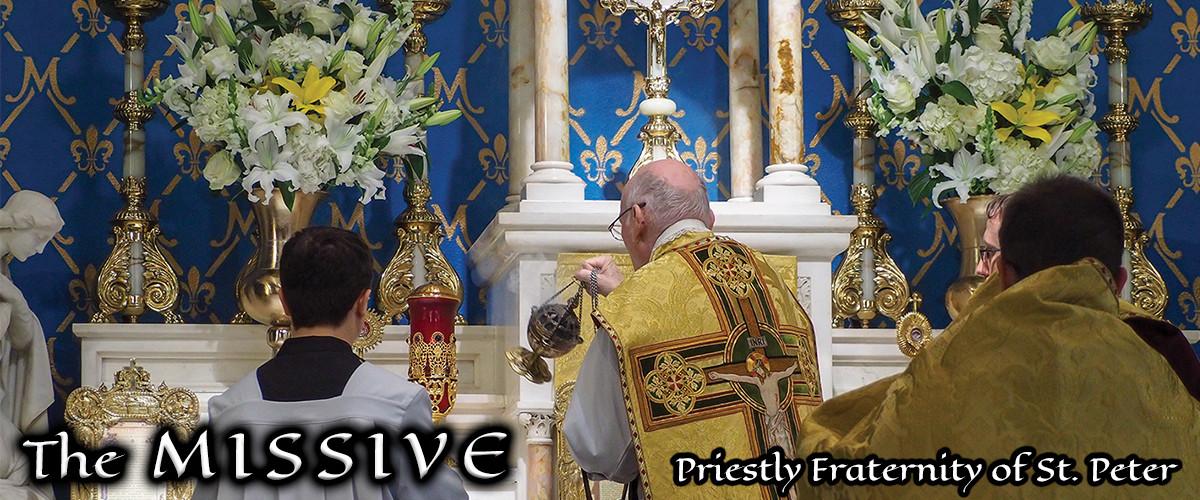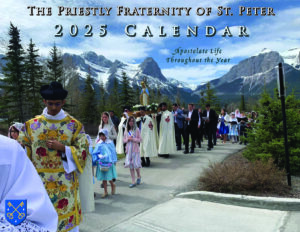Sancta Nox: A New FSSP Christmas Album
We are delighted to announce a brand-new album by the seminarians of Saint Peter Wigratzbad, to be released tomorrow.
From the website of de Montfort Music:
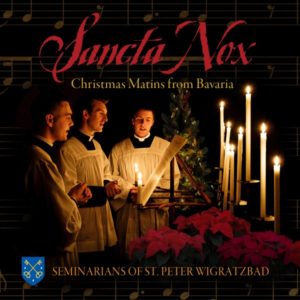 ‘Sancta Nox’, the debut record label release by The Seminarians of Saint Peter Wigratzbad, was recorded in Germany by two of the top talents working in classical music today: 10x Grammy Award-winning producer Christopher Alder and engineer Christian Weigl, also a Grammy winner. “Sancta Nox: Christmas Matins from Bavaria by the Seminarians of Saint Peter Wigratzbad” was recorded in an ancient 12th century abbey with state-of-the-art acoustics called St. Magnus Abbey, Bad Schussenried which was custom built for monastic singing. The recording label is De Montfort Music, which has helped cultivate a new audience for ancient choral music by developing several chart-topping albums of chant. This latest recording transfigures the sound of anticipation and remembrance into something mystical and beautiful, inspiring a feeling of hope in the cycle of life and an embrace of the eternal through the gift of meditative song. SANCTA NOX: Christmas Matins from Bavaria is a uniquely curated presentation, comprising 17 tracks of sublime melody, mostly monophonic Gregorian chant but concluding with a moving multi-lingual arrangement of the beloved classic Stille Nacht.
‘Sancta Nox’, the debut record label release by The Seminarians of Saint Peter Wigratzbad, was recorded in Germany by two of the top talents working in classical music today: 10x Grammy Award-winning producer Christopher Alder and engineer Christian Weigl, also a Grammy winner. “Sancta Nox: Christmas Matins from Bavaria by the Seminarians of Saint Peter Wigratzbad” was recorded in an ancient 12th century abbey with state-of-the-art acoustics called St. Magnus Abbey, Bad Schussenried which was custom built for monastic singing. The recording label is De Montfort Music, which has helped cultivate a new audience for ancient choral music by developing several chart-topping albums of chant. This latest recording transfigures the sound of anticipation and remembrance into something mystical and beautiful, inspiring a feeling of hope in the cycle of life and an embrace of the eternal through the gift of meditative song. SANCTA NOX: Christmas Matins from Bavaria is a uniquely curated presentation, comprising 17 tracks of sublime melody, mostly monophonic Gregorian chant but concluding with a moving multi-lingual arrangement of the beloved classic Stille Nacht.
Many have heard The Seminarians sing this Matins repertoire leading up to Christmas services over the years, often suggesting that the group record and capture this stirring moment of the season. The text – beginning with “Dómine, lábia mea aperies Et os meum annuntiábit laudem tuam” (“O Lord, open Thou my lips. And my mouth shall declare Thy praise”) – is spiritually uplifting, meant to convey souls to a particular vision of something larger to come; the effect of the music is far-reaching and timeless, bound to touch the deepest emotions of any human heart.
Samples available at de Montfort Music, and you can order a copy of this wonderful CD at fraternitypublications.com.
September 27, 2021

September Embertide and the Christianizing of Eden
by Fr. William Rock, FSSP
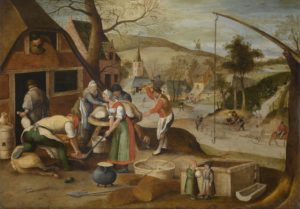
According to the 1962 Liturgical Calendar of the Roman Rite, this Wednesday, Friday, and Saturday are Ember Days. The Ember Days are four sets of three days (Wednesday, Friday, and Saturday) which occur around the transitions of the natural seasons – winter, spring, summer, and autumn.
This year, the Autumn Equinox – when day and night are equal length and which astronomically marks the start of autumn, thus the end of summer, in the Northern Hemisphere – occurs this Wednesday, September 22nd, Ember Wednesday. Historically, the Ember Days were days of penance observed to give thanks to God for His blessings in the previous season and to ask for His blessings for the upcoming one. In 1962, Ember Wednesday and Saturday were days of fasting and partial abstinence – that is, one could take only one full meal and two little meals and meat only at the main meal. The two little meals, when added together, were not to equal a whole meal. Ember Friday, because it is a Friday, would have been a day of fasting and total abstinence, so no meat at all.
The Ember Days were also seen as days of prayer for those who were to be ordained, as ordinations were historically held on the Ember Saturdays. The practice of having ordinations on Ember Saturdays is still reflected in the Masses for the Ember Saturdays and the ordination rites themselves.
While there is no current canonical obligation to keep the upcoming Ember Days as days of penance, the reader is invited voluntarily to do so. Even if one cannot keep them as days of fasting and abstinence, the reader is encouraged to do some form of penance on these three days and to keep them with the same spirit and intentions as our Catholic forefathers – in thanksgiving for the blessings of the previous season, to ask God’s blessing for the upcoming one, and to pray for the clergy, particularly for those studying for the Priesthood. As part of the keeping of the Ember Days, seafood tempura is suggested – a Japanese food which, according to pious tradition, takes its name from the Latin name for the Ember Days, Quatuor Anni Tempora.

That the Latin Church in her liturgical traditions observes, in a way, the transition between the seasons should not be seen as odd or, even worse, pagan. A Catholic lives in this created material world just as much as a pagan does, and both have to live in and by its cycles. Marking the seasons is not distinctly pagan, or distinctly Catholic for that matter, but is simply human, part of the shared human experience. In fact, God intends that the heavenly bodies be used by man in such a way. According to the Book of Genesis, on the Fourth Day, “God said: Let there be lights made in the firmament of heaven, to divide the day and the night, and let them [the heavenly bodies] be for signs, and for seasons, and for days and years:” (Gen 1:14). With this knowledge, one may dare to say that the celebrating of the transitions of the natural seasons belongs most properly and rightly to those who worship the Creator, the True God, the Thrice Holy Trinity, rather than to the pagans. It is worth noting here that the Hebrew word translated as “seasons” can also mean “feasts.”1
Based on what has just been discussed and the requirements of the Natural Law for Divine Worship, it is the contention of this article that, in Eden, the worship of the Creator would have had an astronomical component. Planting and harvest festivals would not have arisen until after the Fall when, as a punishment, man was sentenced to work the land for his sustenance (Gen 3:17-19). Such a post-Fall development would be in keeping with man’s nature, his relationship with God, Who bestows all blessings, and fallen man’s relationship with material creation.
It is true that Man was created in a State of Grace and given a supernatural destiny,2 but he was to achieve this destiny within material creation. He was supernaturally elevated, but he was not, therefore, removed from the natural realm. Rather, he was to live in such a way so that he offered the material creation back to its Creator, acting as a mediator between God and the rest of material creation.
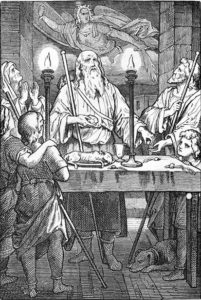
Man’s role of acting as a mediator between God and rest of material creation was not lost with the Fall, nor was the astronomical component of worship. The Hebrews, for example, were instructed to offer sacrifices every day, but to rest on the Seventh Day of the Week, the Sabbath, Saturday, to weekly mark God’s completion of Creation (see Gen 2:2-3; Exo 31:13-17). Several of the Psalms, such as Psalm 135 (according to the Vulgate numbering), hymn God for His works of Creation. Each New Moon was celebrated by the Hebrews with the blowing of the trumpet and marked the beginning of a new month (see Num 10:10). The date of the celebration of the Feast of Passover, and thus of Pentecost, was determined “from astronomical calculations.”3 Additionally, the Hebrew Feasts of Passover and Sukkot (the Feast of Tabernacles) had agricultural connections, Passover with the wheat harvest (see Exo 34:22) and Sukkot with the corn harvest (see Exo 23:16; 34:22). In this manner, the ceremonies of the Old Law incorporated not only the astronomical component of the worship of Eden, but also the post-Fall harvest festivals.
The keeping of the Ember Days, then, in a way returns the Christian to the most primitive type of the worship of God, to Edenic worship, as it were, to the worship of God grounded in and guided by the material creation, in particular the rhythm of the celestial bodies. Just as grace does not destroy nature, but rather builds upon and perfects nature,4 so too does the Catholic Church Christianize this primordial worship of God, elevating and incorporating it into worship of the New Law. This paradigm also explains why abstaining from meat on the Ember Days is especially fitting.
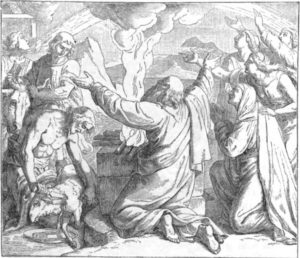
When God placed Man in the Garden, He told them: “behold I have given you every herb bearing seed upon the earth, and all trees that have in themselves seed of their own kind, to be your meat” (Gen 1:29). It was not until after the Fall and after the Flood, that God gave man animals as food: “And God blessed Noe and his sons. And he said to them: Increase, and multiply, and fill the earth. And let the fear and dread of you be upon all the beasts of the earth, and upon all the fowls of the air, and all that move upon the earth: all the fishes of the sea are delivered into your hand. And every thing that moveth, and liveth shall be meat for you: even as the green herbs have I delivered them all to you: saving that flesh with blood you shall not eat” (Gen 9:2-4).5 By abstaining from meat, man is behaving in a more Edenic, pre-diluvian, pre-flood way, a manner of acting which fits perfectly with the Edenic observance of the Ember Days.

But the Ember Days are not the only manner in which the Catholic Church incorporates the material creation into her worship of God. Catholicism, in particular traditional Catholicism, is – and the author can find no better word to describe it – earthy. The Roman Ritual includes blessings for fields, orchards, and vineyards; for seeds and seedlings, for herbs and flowers; for animals and their feed; for bees, for birds, for silkworms, against mice; for fountains and wells; for bonfires; for grapes, fruit, bread, butter, beer, and wine; for wedding chambers; the many sacramentals for expecting mothers, including a blessing of the mother and child. There is a whole ceremony of thanksgiving for the mother after childbirth. Turning to the Missal, there are votive orations for times of famines, for times of earthquakes, and for times of pestilence; for asking for rain, for asking for fine weather, for the repelling of storms. In the Divine Office, in the Times after Epiphany and Pentecost, the Sunday and weekday Vespers Hymns, when there are no feasts, progress day-by-day through the Days of Creation as expressed in Genesis. Again, the Catholic Church incorporates the material creation and our material nature into her worship of God, into her Liturgical Life, and, elevating all this, incorporates them into the rites of the New Law.
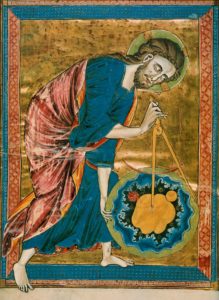
But it is not only Edenic worship which the Catholic Church incorporates and elevates, but also the worship of the Old Law, which itself incorporated post-Fall agricultural worship. The connections between the Jewish Passover and the Christian Holy Week and Easter and between the Jewish Pentecost and the Christian Pentecost are perhaps the most well-known (the dates of these Jewish Feasts, as noted above, being determined astronomically). But other Jewish Feasts are still marked in some manner by Christians. It has been noted that Ember Wednesday of September shares themes with Rosh Hashanah, the Jewish New Year.6 This year Rosh Hashanah was celebrated during the first week of September, just a few weeks prior to this year’s Ember Wednesday of September (although originally the New Year was celebrated around Passover, see Exo 12). The institutions of Yom Kippur, the Day of Atonement, and Sukkot, the Feast of Tabernacles, are read during the Mass of September’s Ember Saturday. This year, the Ember Saturday of September will be celebrated on September 25th, shortly following this year’s celebration of Yom Kippur, September 15th-16th. The celebration of Sukkot, September 20th-27th, overlaps with this year’s September Embertide.
So not only do the September Ember days mark the transition from summer to autumn, but they also Christianize the Jewish festivals of Rosh Hashanah, Yom Kippur, and Sukkot and that more-or-less coincidently with the Jewish feasts themselves. Other examples of the Liturgy of the New Law preserving and elevating elements of worship from the Old Law can be brought forward, but this will suffice for now.
Let us then, dear reader, as we worship God according to the Rites of the Latin Church, bear in mind that by them we are participating in an elevation and preservation of the astronomical worship of Eden, post-Fall agricultural worship, and the worship of the Old Law. And may all this particularly be kept in mind during this upcoming September Embertide, which you are invited to keep in the same spirit and practice as our Catholic forefathers.
Fr. William Rock, FSSP was ordained in the fall of 2019 and is currently assigned to Regina Caeli Parish in Houston, TX.
1. Strong’s Dictionary, H4150.
2. Ott, Ludwig, Fundamentals of Catholic Dogma. Baronius Press, 2018, p. 113.
3. Catholic Encyclopedia, s.v. “Pasch or Passover.”
4. See S.T. I, q. 1, a. 8, ad 2.
5. See Dom Guéranger’s The Liturgical Year – Lent (History of Lent).
6. Kunitz-Dick, Alisa. Audi, Israël: Jewish Feasts in the Propers of the Traditional Roman Rite
September 20, 2021

Exaltation of the Holy Cross + Seven Sorrows of the BVM: 7 Masses for the sick and sorrowing
Hence that uninterrupted community of life and labors of the Son and the Mother, so that of both might have been uttered the words of the Psalmist, “My life is consumed in sorrow and my years in groans” (Ps xxx. 11). When the supreme hour of the Son came, beside the Cross of Jesus there stood Mary His Mother, not merely occupied in contemplating the cruel spectacle, but rejoicing that her Only Son was offered for the salvation of mankind….
—Pope Pius X
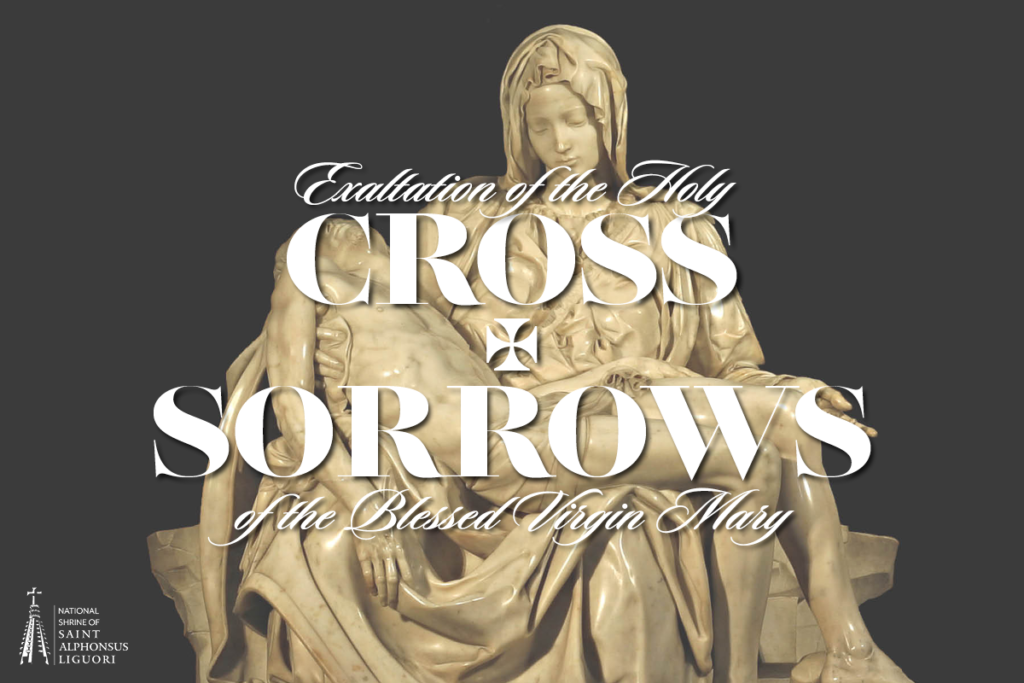
What extraordinary grace filled Our Savior and His Mother at the Cross!
Not only did God’s grace hold Them up under the most unendurable weight of suffering, but it transformed Their sorrow and pain into a love so profound that They could rejoice, even in that darkest of hours, in the overwhelming glory of God and in the beautiful hope of our salvation.
We need that grace, too, to survive our trials and crosses – and to see in the midst of darkness that glorious hope that shall be the source of all our joy and the reason we press on. Let us find at the foot of the Cross, by Our Lady’s help, the graces we need in our sufferings.
The FSSP’s apostolate in Baltimore, the National Shrine of Saint Alphonsus Liguori, begins a new tradition this year.
In honor of the twin feasts of the Exaltation of the Holy Cross on 14 September and Our Lady of Sorrows on 15 September, they will offer seven Masses, in union with the seven sorrows of Our Lady to which the month of September is dedicated, for those who are sick and sorrowing – that they may find healing and peace at the foot of the Cross with Our Lady.
These two feasts, so intimately intertwined, are a way for us to unite all our trials to the Cross of Christ as we celebrate the Holy Sacrifice of the Mass and stand at the foot of Calvary with our Lady. May we have the Heart of our Lady and receive the courage and strength we need to carry our own Crosses in imitation of our Crucified Lord.
Visit their website to enroll your intentions and make a donation to support the spiritual work of the Shrine.
https://stalphonsusbalt.org/cross-sorrows
September 14, 2021

Communique of the Superiors-General of the “Ecclesia Dei” Communities
Superior General Andrzej Komorowski, FSSP and the other heads of various “Ecclesia Dei” communities met this past week in Courtalain in France and wrote a communique directed to the Bishops of France–not to the Holy See or the Church at large. The statement is now widely circulating online, but we wished to republish it here with that slight clarification about its intended audience. –ed.

Communique of the Superiors-General of the “Ecclesia Dei” Communities
“The mercy of the Lord is upon all flesh.”
(Sirach 18, 13)
The signatory Institutes want, above all, to reiterate their love for the Church and their fidelity to the Holy Father. This filial love is tinged with great suffering today. We feel suspected, marginalized, banished. However, we do not recognize ourselves in the description given in the accompanying letter of the Motu Proprio Traditionis custodes, of July 16, 2021.
“If we say we have no sin …” (I John 1, 8)
We do not see ourselves as the “true Church” in any way. On the contrary, we see in the Catholic Church our Mother in whom we find salvation and faith. We are loyally subject to the jurisdiction of the Supreme Pontiff and that of the diocesan bishops, as demonstrated by the good relations in the dioceses (and the functions of Presbyteral Councillor, Archivist, Chancellor, or Official which have been entrusted to our members), and the result of canonical or apostolic visits of recent years. We reaffirm our adherence to the magisterium (including that of Vatican II and what follows), according to the Catholic doctrine of the assent due to it (cf. in particular Lumen Gentium, no. 25, and Catechism of the Catholic Church , no. 891 and 892), as evidenced by the numerous studies and doctoral theses carried out by several of us over the past 33 years.
Have any mistakes been made? We are ready, as every Christian is, to ask forgiveness if some excess of language or mistrust of authority may have crept into any of our members. We are ready to convert if party spirit or pride has polluted our hearts.
“Fulfill your vows unto the Most High” (Psalm 49:14)
We beg for a humane, personal, trusting dialogue, far from ideologies or the coldness of administrative decrees. We would like to be able to meet a person who will be for us the face of the Motherhood of the Church. We would like to be able to tell him about the suffering, the tragedies, the sadness of so many lay faithful around the world, but also of priests, men and women religious who gave their lives trusting on the word of Popes John Paul II and Benedict XVI.
They were promised that “all measures would be taken to guarantee the identity of their Institutes in the full communion of the Catholic Church”[1]. The first Institutes accepted with gratitude the canonical recognition offered by the Holy See in full attachment to the traditional pedagogies of the faith, particularly in the liturgical field (based on the Memorandum of Understanding of May 5, 1988, between Cardinal Ratzinger and Archbishop Lefebvre). This solemn commitment was expressed in the Motu Proprio Ecclesia Dei of July 2, 1988; then in a diversified manner for each Institute, in their decrees of erection and in their constitutions definitively approved. The men and women religious and priests involved in our Institutes have made vows or made commitments according to this specification.
It is in this way that, trusting in the word of the Supreme Pontiff, they gave their lives to Christ to serve the Church. These priests and men and women religious served the Church with dedication and abnegation. Can we deprive them today of what they are committed to? Can we deprive them of what the Church had promised them through the mouth of the Popes?
“Have patience with me!” (Mt 18:29)
Pope Francis, “encourage[s] the Church’s pastors to listen to them with sensitivity and serenity, with a sincere desire to understand their plight and their point of view, in order to help them live better lives and to recognize their proper place in the Church.”(Amoris Laetitia, 312). We are eager to entrust the tragedies we are living to a father’s heart. We need listening and goodwill, not condemnation without prior dialogue.
The harsh judgment creates a feeling of injustice and produces resentment. Patience softens hearts. We need time.
Today we hear of disciplinary apostolic visits to our Institutes. We ask for fraternal meetings where we can explain who we are and the reasons for our attachment to certain liturgical forms. Above all, we want a truly human and merciful dialogue: “Have patience with me!”
“Circumdata varietate” (Ps 44:10).
On August 13, the Holy Father affirmed that in liturgical matters, “unity is not uniformity but the multifaceted harmony created by the Holy Spirit”[2]. We are eager to make our modest contribution to this harmonious and diverse unity, aware that, as Sacrosanctum Concilium teaches, “the liturgy is the summit toward which the activity of the Church is directed; at the same time it is the font from which all her power flows” (SC, n ° 10).
With confidence, we turn first to the bishops of France so that a true dialogue be opened and that a mediator be appointed who will be for us the human face of this dialogue. We must, “avoid judgements which do not take into account the complexity of various situations … It is a matter of reaching out to everyone, of needing to help each person find his or her proper way of participating in the ecclesial community and thus to experience being touched by an ‘unmerited, unconditional and gratuitous’ mercy.” (Amoris Laetitia, no. 296-297).
Done at Courtalain (France), August 31, 2021.
Fr. Andrzej Komorowski, Superior-General of the Fraternity of Saint Peter
Msgr. Gilles Wach, Prior General of the Institute of Christ the King Sovereign Priest
Fr. Luis Gabriel Barrero Zabaleta, Superior-General of the Institute of the Good Shepherd
Fr. Louis-Marie de Blignières, Superior-General of the Fraternity of Saint Vincent Ferrer
Fr. Gerald Goesche, General Provost of the Institute of Saint Philip Neri
Fr. Antonius Maria Mamsery, Superior-General of the Missionaries of the Holy Cross
Dom Louis-Marie de Geyer d’Orth, Father Abbot of the Abbey of Saint Magdalen of Le Barroux
Fr. Emmanuel-Marie Le Fébure du Bus, Father Abbot of the Canons of the Abbey of Lagrasse
Dom Marc Guillot, Father Abbot of the Abbey of Saint Mary of la Garde
Mother Placide Devillers, Mother Abbess of the Abbey of Our Lady of the Annunciation of Le Barroux
Mother Faustine Bouchard, Prioress of the Canonesses of Azille
Mother Madeleine-Marie, Superior of the Adorers of the Royal Heart of Jesus Sovereign Priest
_____________
[1] Informative Note of June 16, 1988, in Documentation Catholique, no. 1966, p. 739.
[2] Video Message of Pope Francis to the participants of the Congress on Religious Life.
Translation from Rorate Caeli. Original French document: Notre-Dame de Chrétienté/ Paris-Chartres Pilgrimage.
September 3, 2021

Confraternity Message from Fr. Reiner, FSSP
Dear members of the Confraternity,
The Motu proprio Traditionis Custodes and its accompanying letter from Pope Francis have shocked us all. We have not yet been informed of any definitive decisions regarding the future of the Priestly Fraternity of St. Peter and its apostolates. Even though the first reactions of various bishops have been rather reassuring and have not involved any significant restrictions, nevertheless, in the coming weeks various bishops’ conferences will discuss the matter on the occasion of this motu proprio and possibly take decisions that will be groundbreaking for us. The Roman Congregation for Religious Orders, which in the future will be responsible for us instead of the “Ecclesia Dei” Commission, will also begin its work in a few weeks and will also make the first decisions concerning the Priestly Fraternity of St. Peter.
For these decisions, which are important for us and which bishops and cardinals will make in the near future, I would like to ask you, as the closest confidants of our Fraternity, most sincerely for your prayers. Through our prayers, let us consciously place the future of the Priestly Fraternity of St. Peter in the hands of the Blessed Virgin Mary. Her intercession and maternal protection will lead the Fraternity into the future in a way that is in accordance with the Divine Will. For this purpose, I would like to create the so-called “Living Rosary”. For this purpose we have created a simple homepage, which you can find at www.fssp.de/rosarium and register there.
In the columns of the table you will find numbers 1 to 30, which stand for the 30 days of the coming month of September. Each day is divided into sections of 20 minutes from 0:00 to 24:00 (Central European Time), in which two people can sign in with a simple click. With the first click, the corresponding field turns yellow and the number 1 appears. Once a yellow field is clicked, another person can click on it again, then the field turns green and the number 2 appears. The goal is for each field to appear green, that is, for at least two people to pray the rosary during the corresponding period. If you make a mistake and you would like to pray the Rosary at another time, you can click on the box another time and your entry will be deleted.
With your help, the Rosary will be prayed without interruption during the month of September. Since there are about 8000 members in the Confraternity of St. Peter worldwide, not all of them can register in this table. But even if all the fields of the table are already set to green, I would like to ask all the other members of the Confraternity who could not register to participate by praying at least one rosary. The times of the table rows are given according to Central European Time (Berlin), i.e. each member should calculate the time difference himself according to his place of residence. I would ask that the American members predominantly adopt the European night hours. Not all members of the Confraternity have internet access or can be reached by e-mail. If you know of any such members, I would ask that you pass this prayer request on to them. It would be beautiful if we could succeed in continuously assailing Heaven with about 8000 rosaries prayed during the month of September.
Each rosary should be prayed with the following intention: We pray for our Holy Father and for all the bishops, as well as all those in authority in the Church who will have to make significant decisions regarding the Priestly Fraternity of St. Peter in the near future. We pray for all the priests and seminarians of the Priestly Fraternity of St. Peter, that they may continue to carry out their ministry in the Church with fidelity, reverence and obedience, giving guidance to the faithful through a clear ecclesial and humble attitude. We pray for all the faithful in our apostolates and for all the people attached to the traditional Mass, that they will not lose heart, but will be able to accept this time of trial and, with the help of God’s grace, come out of it stronger.
United in prayers,
Father Stefan Reiner
Chaplain General of the Confraternity of St. Peter
For more on the Confraternity, see: https://fssp.com/confraternity-of-saint-peter/
August 27, 2021

Unique for Unique – Natural Requirements for Divine Worship
by Fr. William Rock, FSSP
It is incumbent upon each of us to know the relationships we are in and to act appropriately with respect to each.1 It is, for example, important and imperative for a husband and father to know whom his wife and children are and to act towards them in a fitting manner. The most important relationship each one of us has, however, is our relationship with God. This is because each of us has a relationship with God which we do not and cannot have with anyone else – we each depend upon God for our continued existence. For not only did God create each of us, He also maintains each of us in existence, in being, from moment to moment. If He were to cease to maintain this support, we would not die, we would cease to exist altogether, returning to the nothingness from which we were drawn.2
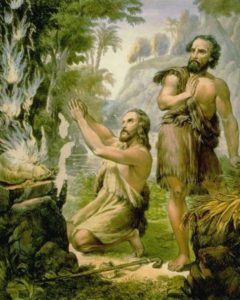
It is incumbent, then, that each recognize that we have this dependence on God. But mere intellectual recognition is not enough. As man is a composite of soul and body, the acknowledgement of this relationship, this dependence, by the intellect should be manifested externally.3 And, since our relationship to God is wholly unique, this external manifestation or expression should be wholly unique. Unique for unique. Now the unique expression of the recognition of this unique relationship is, historically and universally, sacrifice.4 “Described in simple terms, sacrifice is the offering of a gift to God. Man, the creature, instinctively realizes that when he comes formally into the presence of his Creator, he must bear with him a gift as the supreme token of his respect. This gift is some material thing of value: it is a symbol of God’s supreme dominion over all things, especially over man, for whom it is substituted. To signify its return to God’s exclusive possession, the gift is destroyed or altered in some way.”5 To put it another way, a sacrifice “is the offering to God of some sanctified object, made by a legitimate priest, who destroys or otherwise changes that object in acknowledgement of God’s supreme dominion over man.”6
It is natural for man, as he is a social creature by nature,7 to join with other men when undertaking things of great importance,8 including that of offering sacrifice to their common Creator Who has dominion over each and all. But, in order to safeguard the expression of the unique relationship between each man and God, the unique action of sacrifice, when performed in common, must be surrounded by the other unique things – rites, “languages, vestments, vessels, places, and even persons.”9 Unique for unique.

It is important to note here, as a consequence, that religious services which more poorly express this required uniqueness, either with regards to sacrifice or the surrounding ceremonies, are naturally inferior to those which express this required uniqueness well. Conversely, those which express this required uniqueness well are naturally superior to those which express it more poorly. Additionally, since this required uniqueness springs from man’s relationship with God and from the requirements of man’s nature, religious ceremonies in which this required uniqueness is completely absent are contrary to human nature.
This required uniqueness in the worship of the Creator, which springs from human nature and each one’s relationship with the Divine, serves as an objective standard by which to evaluate religious services and, in particular, those in which sacrifice is offered. As such, these requirements are eminently applicable to the Sacrifice of the New Law (The Holy Mass/Divine Liturgy/Holy Qurbana) and thus raise the discussion about different forms and celebrations of this Sacrifice above subjective tastes and preferences. After all, Christianity, though it deals with the supernatural, does not deny human nature, but rather presumes human nature and perfects it,10 divine worship not excepted.
Fr. William Rock, FSSP was ordained in the fall of 2019 and is currently assigned to Regina Caeli Parish in Houston, TX.
1 This article draws heavily from a course (The Natural Superior of Traditional Worship) given in 2018 by the International Society of Scholastics.
2 See S.T. I, q. 104, a.2.
3 See S.T. II-II, q. 84, a.2.
4 See S.T. II-II, q. 85.
5 Higgins, Thomas J. Man as Man – The Science and Art of Ethics. Milwaukee: Bruce, 1949, n. 342.
6 Ripley, Francis. This is the Faith. Rockford: Tan, 2002, p. 268.
7 See Aristotle. Politics, 1253a
8 See St. Thomas. De regno, I.1.
9 The Natural Superior of Traditional Worship, slides 17, 32.
10 See S.T. I, q. 1, a. 8, ad 2.
August 16, 2021

Homily on the Feast of St. Lawrence, by Pope St. Leo the Great
The following is a homily given in the mid-fifth century by Pope St. Leo the Great. As Father Lasance notes, Lawrence was so dearly venerated in Rome that his feast was one of the greatest saints’ days in the ancient Roman liturgy, second only to that of Ss. Peter and Paul.
Dearly beloved,
The height of all virtues and the fullness of all righteousness is born of the love of God and one’s neighbor, but surely in none is this love found more conspicuous and brighter than in the blessed martyrs. They are as near to our Lord Jesus, Who died for all men, in the imitation of His love, as in the likeness of their suffering.
The Love whereby the Lord has redeemed us cannot be equaled by any man’s kindness: because it is one thing that a man who is doomed to die one day should die for a righteous man, and another that One Who is free from the debt of sin should lay down His life for the wicked.
Yet the martyrs also have done great service to all men. The Lord Who gave them boldness, has used it to show that the penalty of death and the pain of the cross need not be terrible to any of His followers, but might be imitated by many of them.
If therefore no good man is good for himself alone, and no wise man’s wisdom befriends himself only, and the nature of true virtue is such that it leads many away from the dark error on which its light is shed, no model is more useful in teaching God’s people than that of the martyrs.
Eloquence may make intercession easy. Reasoning may effectually persuade. But examples are stronger than words, and there is more teaching in practice than in precept.
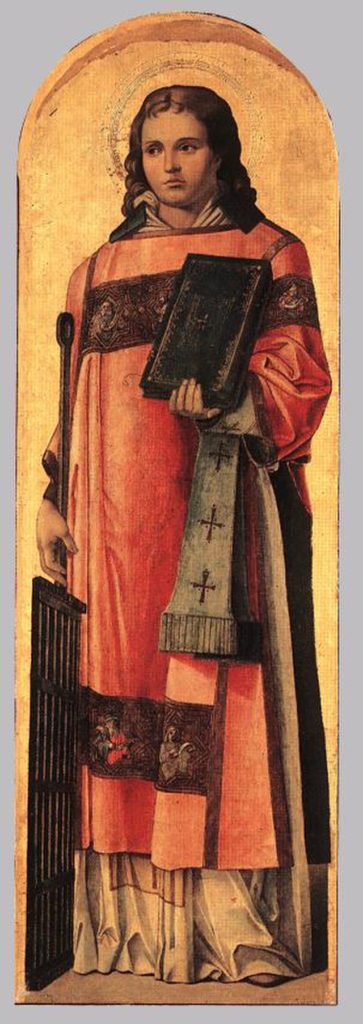 And how gloriously strong in this most excellent manner of doctrine the blessed martyr Lawrence is, by whose sufferings today is marked! Even his persecutors were able to see it, when they found that his wondrous courage, born principally of love for Christ, not only did not yield, but also strengthened others by the example of his endurance.
And how gloriously strong in this most excellent manner of doctrine the blessed martyr Lawrence is, by whose sufferings today is marked! Even his persecutors were able to see it, when they found that his wondrous courage, born principally of love for Christ, not only did not yield, but also strengthened others by the example of his endurance.
For when the fury of the gentile potentates was raging against Christ’s most chosen members, attacking those especially who were of priestly rank, the wicked persecutor’s wrath was vented on Lawrence the deacon, who was pre-eminent not only in the performance of the sacred rites, but also in the management of the church’s property. The persecutor promised himself double spoils from one man’s capture: for if he forced Lawrence to surrender the sacred treasures, he would also drive him out of the pale of true religion.
So this man, greedy of money and a foe to the truth, armed himself with two weapons: avarice to plunder the gold, and impiety to carry off Christ. He demanded the guileless guardian of the sanctuary to bring him the church’s wealth, on which his greedy mind was set.
But the holy deacon showed him where he had them stored: he pointed to the many troops of poor saints.
Feeding and clothing them was a store of riches which he could not lose, and which were all the more safe since the money had been spent on so holy a cause.
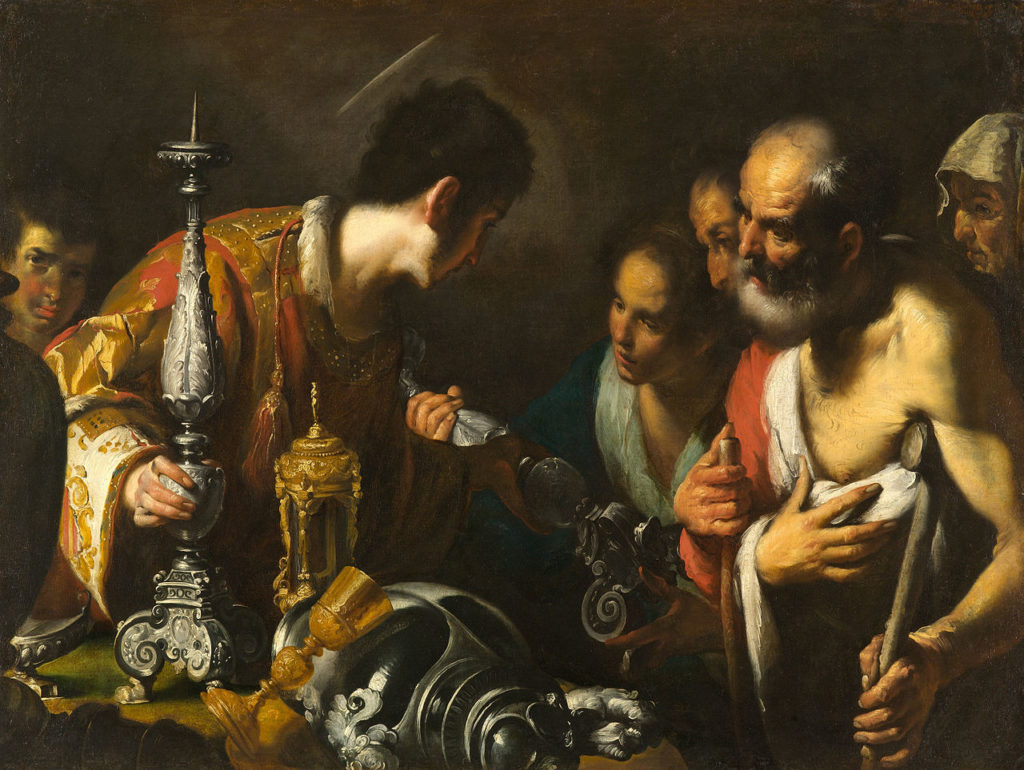
At this, the baffled plunderer became agitated. Blazing out into hatred of a religion, which had put riches to such a use, and as he could find no solid hoard of money in the saint’s possession, he determined to pillage a still greater treasure by carrying off that sacred deposit wherewith Lawrence was enriched.
He ordered Lawrence to renounce Christ, and prepared to ply the deacon’s stout courage with frightful tortures. When the first tortures elicited nothing, fiercer ones followed. Lawrence’s limbs, torn and mangled by many cutting blows, were commanded to be broiled upon the fire in an iron framework, which was already hot enough to burn him, and on which his limbs were turned from time to time, to make the torment fiercer, and the death more lingering.

You gain nothing, you prevail nothing, o savage cruelty! Lawrence’s mortal frame is released from your devices, and, when he departs to heaven, you are vanquished.
The flame of Christ’s love could not be overcome by your flames, and the fire which burnt outside was less keen than that which blazed within!
You but served the martyr in your rage, O persecutor: you but swelled the reward in adding to the pain. For what did your cunning devise, which did not redound to the conqueror’s glory, when even the instruments of torture were counted as part of the triumph?
Let us rejoice, then, dearly-beloved, with spiritual joy! Let us make our boast over the happy end of this illustrious man in the Lord, Who is wonderful in His saints. In him the Lord has given us a support and an example, and has so spread abroad his glory throughout the world, that, from the rising of the sun to its going down, the brightness of his deacon’s light does shine.
And Rome has become as famous in Lawrence as Jerusalem was ennobled by Stephen.
Because, as the Apostle says, all who wish to live holy lives in Christ suffer persecution, by his prayer and intercession we trust at all times to be assisted. And may we be strengthened with the spirit of love and be fortified to overcome all temptations by the perseverance of steadfast faith.
August 10, 2021

Ad Te Levavi – A Hint of Violet in Summer Green
Wherever the ferial Mass was said today, you may have noticed that the Offertory text, from the 10th Sunday of Pentecost just passed, was Ad te levavi.
This text is best known as the Introit and Offertory of the First Sunday of Advent; thus the very first text of the liturgical year, It also sees use in the Offertory of Wednesday in the second week of Lent.

Here in the middle of the lush, green Post-Pentecost season we are, quite deliberately it seems, transported back thematically to those more austere violet seasons earlier in the year. It would be well to think about why that is.
Advent, we recall, begins cataclysmically with the end of the world, and its Ad te levavi is rather more urgent than just a benign prayer of union. “To thee have I lifted up my soul: in Thee, O my God, I put my trust” is not just a nice sentiment, it is a plaintive cry to God amidst profound turmoil. Perhaps, in context, it even has overtones of the final offering up of a soul in the face of imminent death.
We seem to be in a similarly dire liturgical context today. A week and a half ago, at the Gospel of the 9th Sunday after Pentecost, we saw Christ weeping over Jerusalem, foretelling its destruction and the razing of the temple, of which would not be left “a stone upon a stone.” The historical record tells us that this came to pass all too soon, at the hands of the Roman legions in the Jewish War.
 As Dom Gueranger notes, today’s ferial Gospel of the Parable of the Pharisee and the Publican is symbolically connected to that historical event; Bede and other commentators have seen these two figures as respective symbols of the Synagogue and the Church.
As Dom Gueranger notes, today’s ferial Gospel of the Parable of the Pharisee and the Publican is symbolically connected to that historical event; Bede and other commentators have seen these two figures as respective symbols of the Synagogue and the Church.
More obvious, from a modern Catholic’s standpoint, is how Jerusalem’s destruction in the Ninth Sunday echoes the world’s imminent destruction in the last Sundays of the year.
The closer we get to the latter, it will be increasingly too late to substantially reform ourselves. The just and the wicked alike will only have time to cry for mercy over and over, as the sacred liturgy does with its incessant repetition of the De Profundis in those last Sundays of the year.
A week later, the first Mass of Advent manages to squeeze in a few last cries for mercy, a few last pleas and petitions right through to the Epistle.
But then the Gospel hits with terrifying force. The Lucan passage has no exhortations to virtue, no pleas to reform one’s life–all that time has now passed. Christ’s solemn words to us this day are simply about what cataclysmic signs to expect at the end.

Seeing the Ad te levavi in the Offertory of the 10th Sunday may well cause us to think of all these sobering things. Then, when we raise our heads from our missals we find ourselves, gratefully, back amidst the sunshine and summer greenery.
If we are tempted, however, to rest in Pharisaic self-satisfaction at being among the chosen who recognized the day of our Savior’s coming, Gueranger sounds a solemn warning for us:
But while adoring the justice of God’s vengeance and giving praise to his mercy, the Gentiles must take care not to go into the path wherein was lost the unhappy people, whose place they now occupy. Israel’s offense, says St. Paul, has brought about the salvation of the Gentiles; but his pride would be also their ruin; and whereas Israel is assured, by prophecy, of a return to God’s favor when the end of the world shall be approaching—there is no such promise of a second call of mercy to the Gentiles, should they ever apostatize after their baptism.
That last sentence is a chilling thought for our future, given the state of modern Christendom. But the final hour has not yet come.
Rather, in both the Northern Hemisphere and the Church’s liturgy, the summer is just starting a slow wind-down. As long as there is green there is hope to re-orient ourselves toward God. And the traditional Roman liturgy will never stop exhorting us to do so–right to the bitter end. As Gueranger explains:
Each Epistle and Gospel, especially; and then, each Introit and Collect, each Gradual and Offertory, each Secret, Communion and Postcommunion, each of these will be a precious and exquisitely varied instruction. We shall see all this in the Epistle of this tenth Sunday. …. We have much to learn from the tone our holy Mother the Church puts in the Liturgy of these remaining seventeen Pentecostal Sundays. In the admirable teachings she is now going to give to her children, there is no logical arrangement or sequel. She is as intent as ever on leading souls to holiness and perfection; yet it is not by following a method of any sort, but by her applying to us the united power of the divine Sacrifice and the word of the Scripture, to which she sweetly adds her own.
By putting in the effort now, by humbling ourselves, allowing the fruits of Pentecost to work in us, and paying close attention to the instructions that are offered to us in the sacred liturgy these next few months, we will be able to pray honestly and truly on November 28th:
To thee, O Lord, have I lifted up my soul.
August 3, 2021

Aug. 2: St. Alphonsus Novena for the Lost Sheep
Each year on its parish feast day, the FSSP’s apostolate in Baltimore begins a novena of Masses for the return of lost sheep. They call on their patron, Saint Alphonsus Liguori, who is also the patron saint of joints and connections in the body, to implore for us the healing of connections within the Mystical Body, the Church.
God granted Saint Alphonsus a powerful gift for the conversion of souls. And because so many of us know and pray for our loved ones who have fallen away from their faith and the Church, his burning zeal for the conversion of souls and his assuredly earnest intercession strengthens our hope.

The Novena of Masses begins on the parish’s feast day, 2 August, and concludes with the High Mass offered on Sunday, 8 August, celebrated as the External Solemnity of Saint Alphonsus Liguori. A procession with the statue of their patron through some of the most blighted streets in Baltimore, passing both a mosque and a Planned Parenthood clinic – as well as the chancellory and first cathedral of America’s premier see – follows the Mass.
You may watch the live broadcast of the initial evening Mass on 2 August and also the concluding High Mass on 8 August via their website.
https://www.youtube.com/watch?v=VMSWPCGKH9o
They also invite you to enroll your specific intentions for the return of lost sheep. All Masses during the Novena will be offered for them.
Visit St. Alphonsus’s website for more information or to enroll: https://stalphonsusbalt.org/saint-alphonsus-novena
July 30, 2021

Portrait of the Soul Identified with Jesus
The following excerpt is taken from One with Jesus (1953), by Fr. Paul de Jaegher, SJ.
We will here sketch briefly the psychology of a soul whose spiritual life is summed up in this very simple idea: Living for Jesus; or, to be more exact: Allowing Jesus to live in me. This sketch will do more than lengthy reasoning to bring into relief the features of such a soul.
 To begin with, let us see what her manner of prayer is, independently of the mystic state in which she may or may not find herself.
To begin with, let us see what her manner of prayer is, independently of the mystic state in which she may or may not find herself.
It is clear that such a soul no longer prays for her own sake as she did formerly; her prayer is not hers alone; it is, before all, the prayer of Jesus; one might say it is solely his.
She knows well that she does not pray alone, but that her Well-Beloved prays with her. Therefore it is in this disposition that she goes to prayer. With what joy does she now say “Our Father, who art in Heaven”! God is truly for her “our” Father, the Father of Jesus and her own Father.
Assisted by Jesus who lives in her, she instinctively and gradually reproduces the prayer of Jesus on the mountain. She forgets herself, she forgets her narrow interests and the pettiness which she showed in the past, and her prayer becomes expansive beyond measure. When she adores, her adoration is no longer the adoration offered by her own poor little self ; it is the immense worship which Jesus offers within her, in his own name, and in the name of his whole mystical body.
In Jesus and with Jesus she incessantly gives thanks, not so much for the benefits which she has personally received from God, but for those which God has lavished on Jesus and on all his mystical members. Above all, she loves God passionately for Jesus, and, in the Name of Jesus, she loves him also tor those countless millions of men who do not love him, or who, alas, love him too little.
The soul that lives in Jesus’ name is no longer weighed down by thoughts of self, making self the centre of her prayer; nor is her prayer concentrated as heretofore on the correction of her faults and failings; her prayer does not principally consist in begging for graces for herself and others. Her happiness is now to contemplate, to enjoy the infinite perfections of her God or of her well-beloved Jesus.
She loves to lose herself, to forget herself, turning towards God in loving contemplation and admiration of the divine perfections, as Jesus himself used to do in his prayer to his Father during his mortal life. For his divine perfections are henceforth her wealth, her treasure, and in them she will find all her happiness.
Her prayer to Our Blessed Lady is similarly affected: for here again it is Jesus who prays through her. She feels it unmistakably and cannot for a moment forget it. Jesus therefore gives her the love of a child. As formerly, rocked in his Mother’s arms, he loved to caress and embrace her, so in that soul and through her he caresses her still; he embraces her, or rests lovingly in her arms.
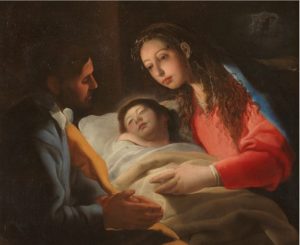 And Mary returns these caresses as she used to return those of her Child Christ. She makes herself so sweet, so delightful, so charming, so intimate, that there are times when the soul is transported with joy, for Mary now so vividly appears to be her mother, her true mother. Our Blessed Lady has become such a living reality to the soul that it seems to her she has never before really known a mother’s love. In the past, Mary meant nothing to her, but now she has truly assumed the office of a mother in her regard. “Ah! I did not know my mother,” the soul at times exclaims, “but now I have found her indeed.”
And Mary returns these caresses as she used to return those of her Child Christ. She makes herself so sweet, so delightful, so charming, so intimate, that there are times when the soul is transported with joy, for Mary now so vividly appears to be her mother, her true mother. Our Blessed Lady has become such a living reality to the soul that it seems to her she has never before really known a mother’s love. In the past, Mary meant nothing to her, but now she has truly assumed the office of a mother in her regard. “Ah! I did not know my mother,” the soul at times exclaims, “but now I have found her indeed.”
These are a few of the principal traits of the prayer of such a soul. But in reality her prayer is not confined to the fixed hours of formal converse with God. The whole day gradually becomes an uninterrupted prayer. Being fully conscious of the presence of Jesus and of his action in her soul, how could she fail to remember him?
Loathing as she does all personal interests and living solely for Jesus and in him, it would be impossible for her not to live continually, or nearly so, with Jesus. In the ardour of her love it seems to her that not to live with Jesus means not to live for him. His companionship alone gives charm and interest to all her actions, of whatever kind they be, and her eager desire to please her Beloved in all things does not permit her to lose sight of him for any length of time.
Who then can express the depth and tenderness of her intimacy with him? She does everything together with the Lover of her soul: she goes to each action hand in hand with him.
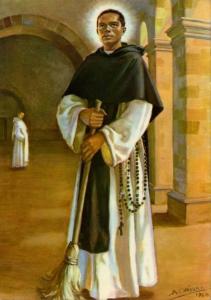
Besides, it is most probable that Jesus himself powerfully helps her to keep alive the remembrance and the consciousness of his Divine Presence. He makes her ascend step by step the degrees of mystical life and prayer, and bestows on her the precious gift of an “active quiet” ever increasing and ever more habitual.
Soon the most distracting occupations cease to absorb her; in her inmost heart she is always actually united with the Master, until she scarcely perceives any difference between the hours of prayer and the hours of work or recreation.
July 26, 2021

